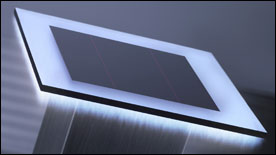
TruMicro Series Lasers
TRUMPF Ltd.Request Info
LUTON, England, Jan. 26, 2011 — Trumpf Ltd.’s TruMicro Series 3000 ultrashort-pulse lasers lower the manufacturing cost of photovoltaic cells and enhance their performance. Maximizing cell efficiency is the result of precise and fine surface structuring, and these lasers do this well and cost effectively.
In the production of solar modules from amorphous silicon or cadmium telluride, conductive and photoactive films are deposited on large substrate areas, such as glass. After every deposition, the laser subdivides the surface so that the cells created are automatically switched in series by the process sequence so that cell and module tensions, depending upon the cell width, can be set.
 The transparent conductive oxides are usually processed with infrared lasers. At typical feed rates, repetition rates of >100 kHz result. An optimized pulse-to-pulse overlap makes for a clean kerf and minimizes negative heat effects.
The transparent conductive oxides are usually processed with infrared lasers. At typical feed rates, repetition rates of >100 kHz result. An optimized pulse-to-pulse overlap makes for a clean kerf and minimizes negative heat effects.
The compact TruMicro Series 3000 instruments, with wavelengths of 1064 and 532 nm, are suitable for P1, P2 and P3 patterning. Thanks to their high pulse-to-pulse stability, these diode-pumped solid-state lasers achieve good processing results, and they can be easily integrated into existing systems because of their advanced cooling design.
Patterning of thin-film cells made from copper indium gallium selenide presents a challenge for the laser process, as does structuring of molybdenum. Picosecond lasers offer a better solution than nanosecond ones for these applications, according to the company.
With these lasers, the material is ablated with ultrashort pulses without significant heating of the process edge zone, preventing cracking, melting and exfoliation of the layers. The company’s Series 5000 picosecond lasers have a wavelength of 1030 nm for structuring molybdenum and 515 nm for processing photoactive material and patterning the front of the contact. Their 50-W output power reduces process costs.
To protect thin-film solar modules against unfavorable environmental influences, especially moisture, a width of ~10 mm of the layer system is ablated along the edge and covered with laminated film. The traditional method employed is sandblasting, but the TruMicro 7050 lasers are more suitable because they can process large areas at production speeds, reliably and securely. They generate 30-ns pulses at an average power of 750 W.
https://www.trumpf.com
/Buyers_Guide/TRUMPF_Ltd/c19263
Published: January 2011
REQUEST INFO ABOUT THIS PRODUCT
* First Name:
* Last Name:
* Email Address:
* Company:
* Country:
Message:
When you click "Send Request", we will record and send your personal contact information to TRUMPF Ltd. by email so they may respond directly. You also agree that Photonics Media may contact you with information related to this inquiry, and that you have read and accept our
Privacy Policy and
Terms and Conditions of Use.
Register or login to auto-populate this form:
Login
Register
* Required